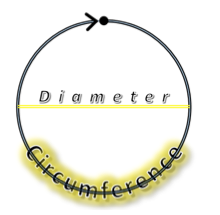Posted in: Aha! Blog > Eureka Math Blog > Conceptual Understanding > Gaining a Profound Understanding of the Value of Pi
STRATEGY
On the fourteenth day of the third month of each year, teachers and students all over the country celebrate what has become known as Pi Day. The significance of this day is its numerical date of 3.14, a common approximation of what some consider to be the most famous ratio value of all, pi. Many celebrate this day by decorating their surroundings with the Greek symbol for pi, π , making creative culinary creations such as pi pie, or challenging their students to memorize as many digits of the value pi as possible. This much celebrated day helps people remember what is arguably the most common approximation of pi but what it fails to do is provide an understanding of what the value of pi is and where it comes from. I recently posted a question on social media requesting that people answer the question: What is pi? The results were nearly as I expected. Responses consisted of 3.14, 3.1415, 22/7, and a misspelled tasty dessert. A few of my teacher friends and colleagues, however, figured out what I was up to.
I am certainly not trying to take the fun out of this most revered day of the year for many math classrooms, but I am trying to show that the fun must not be limited to only one day a year. In Eureka Math Grade 7, Module 3, Lesson 16, students discover a profound understanding of this popular and useful ratio in a very short time using basic everyday materials and a little added guidance.

Consider a circular object such as a bicycle wheel or the top of a large coffee can. The distance around the circle, the circumference, can be found by unrolling the circle along a straight line on a flat plane. Once you have the circumference marked as a linear distance, use the circular item to determine how many diameters, the greatest width of the circle, can fit along the length of the circumference. What you will find is that no matter what size of circle is used, its circumference is a little more than 3 times the length of the diameter. Is this relationship just a coincidence? Let’s take it a step further. If you work to approximate how much more than three times the diameter, you can find that the circumference of the circle is a little more than 3.1 diameters of the same circle.


Beau uses a bicycle wheel to demonstrate circumference during his lesson “The Most Famous Ratio of All” at NCTM 2015 in Boston, MA
At a glance, this might seem like a meaningless observation, but it reveals that the circumference is a constant multiple of the diameter; in other words, there is a multiplicative relationship between the diameter and the circumference of any circle. That is to say that the circumference of any circle is always a little more than 3.1 times the circle’s diameter (See illustration below).

As it turns out, the exact value of the constant of proportionality that relates a circle’s diameter and its circumference in unknown because it is an irrational number. This means that the value is a decimal value that contains an infinite number of digits that have no repeating pattern. There have been many approximations of the value completed using geometric methods in the past, some reaching out to millions of digits in the decimal expansion. Because of the infinite trail of digits, using its exact numerical value in mathematical calculations is impossible. However, knowing how constants and variables behave when used in algebraic expressions and equations allows us to work with the value by assigning a symbol to represent that value without impacting precision in calculation. The symbol that was chosen to represent that value is the symbol for the Greek letter pi, π.
Knowing where the value of pi comes from opens a door to even greater reasoning regarding the calculation of the area of a circle, which can then be extended into other curved figures and three-dimensional geometry. Watch for my next blog post, Why is it important to understand where the value pi comes from?, that will extend the reasoning to the value of pi discussed here to its use in understanding how the circumference and area formulas for circles are derived.
So as the next Pi-Day approaches, consider providing your students with an opportunity to understand the true meaning of that famous value, the value of the ratio of a circle’s circumference to its diameter, that very important ratio value that mathematicians refer to as pi.
Submit the Form to Print
Beau Bailey
Topics: Conceptual Understanding








